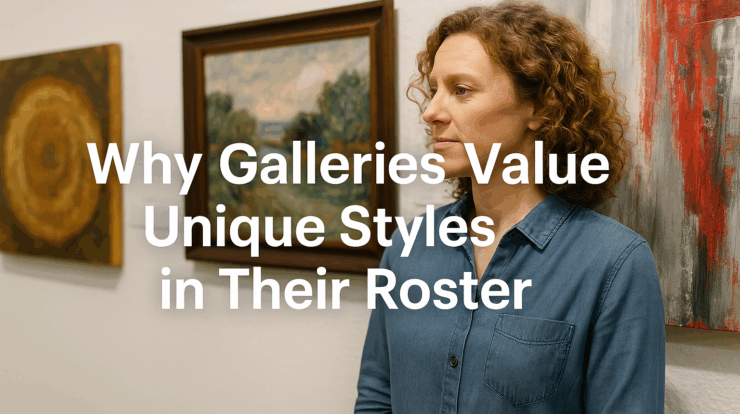
Galleries don’t assemble a random mix of artwork—they curate a lineup that feels cohesive and differentiated. That balance is good for collectors (clear choices, less confusion) and good for the gallery (no artists competing with each other for the same buyer). Your uniqueness isn’t a flourish; it’s a strategic asset.
Why overlap hurts everyone
-
Internal competition: Two artists with near-identical style, subject, and price point split attention and sales.
-
Brand clarity: A roster with copycat work feels muddy. Collectors wonder what the gallery stands for.
-
Pricing pressure: Look-alikes often lead to side-by-side price comparisons and discount requests.
What “unique” means in practice
-
Recognizable through-line: If someone covers the signature on your piece, a regular viewer should still say, “I know who did that.”
-
Distinct recipe: Subject, palette, mark-making, composition, and finish come together in a way that doesn’t read as derivative.
-
Consistency across a series: Exploration is welcome; whiplash isn’t. A gallery needs to trust what will arrive in the next shipment.
How uniqueness increases your appeal
-
You fill a slot the gallery doesn’t have. That makes you easier to champion in sales conversations.
-
Your work strengthens the gallery’s story. Distinct voices make the overall program feel intentional and strong.
-
Marketing is simpler. Clear differentiation gives the gallery obvious angles for press, email features, and social content.
Scout galleries with a “gap finder” mindset
-
Audit the roster: List artists, mediums, dominant palettes, subjects, and price bands.
-
Map the wall: Imagine your best three pieces hanging there. Do they echo someone else—or add missing color, energy, subject, or scale?
-
Check price fit: If your 24×24 is 3–4x higher or lower than similar works on their walls, you’ll fight friction unrelated to quality.
-
Study their buyers: Review sold works online and recent show themes. Where would your work slot into those stories?
If you can point to a clear gap you fill, you’ve got a strong reason to approach.
Strengthen your “we’re not overlapping” case in your pitch
-
Lead with a tight series: 6–10 images that share unmistakable DNA.
-
Call out the gap: One line in your email: “I noticed you don’t currently feature [X: e.g., large-scale tonal abstractions with metallic leaf] in the $2k–$6k range—my work sits there.”
-
Show presentation: Provide framed and in-situ photos so they can picture your pieces on their walls.
-
Offer a focused first shipment: Small, balanced mix (sizes/price points) that complements—not competes with—the roster.
Guardrails to stay unique (and stay in)
-
Maintain a core: Keep your signature elements stable while evolving at the edges.
-
Avoid close imitation: If you admire a roster mate, be careful your next series doesn’t slide toward their look.
-
Review twice a year: Compare your current work to the gallery’s lineup. If overlap grows, adjust before they have to ask.
Quick checklist before you approach
-
Can a regular viewer recognize your work without your name attached?
-
Does your series clearly differ from at least 80% of the gallery’s roster?
-
Do your sizes and prices fill an open lane?
-
Do your materials/finishes add a texture or light quality missing there?
-
Do your in-situ images prove the fit?
Bottom line: Galleries value artists who add a distinct voice to the chorus. Show that your work strengthens the program without crowding anyone else, and you move from “another submission” to “the piece we were missing.”
